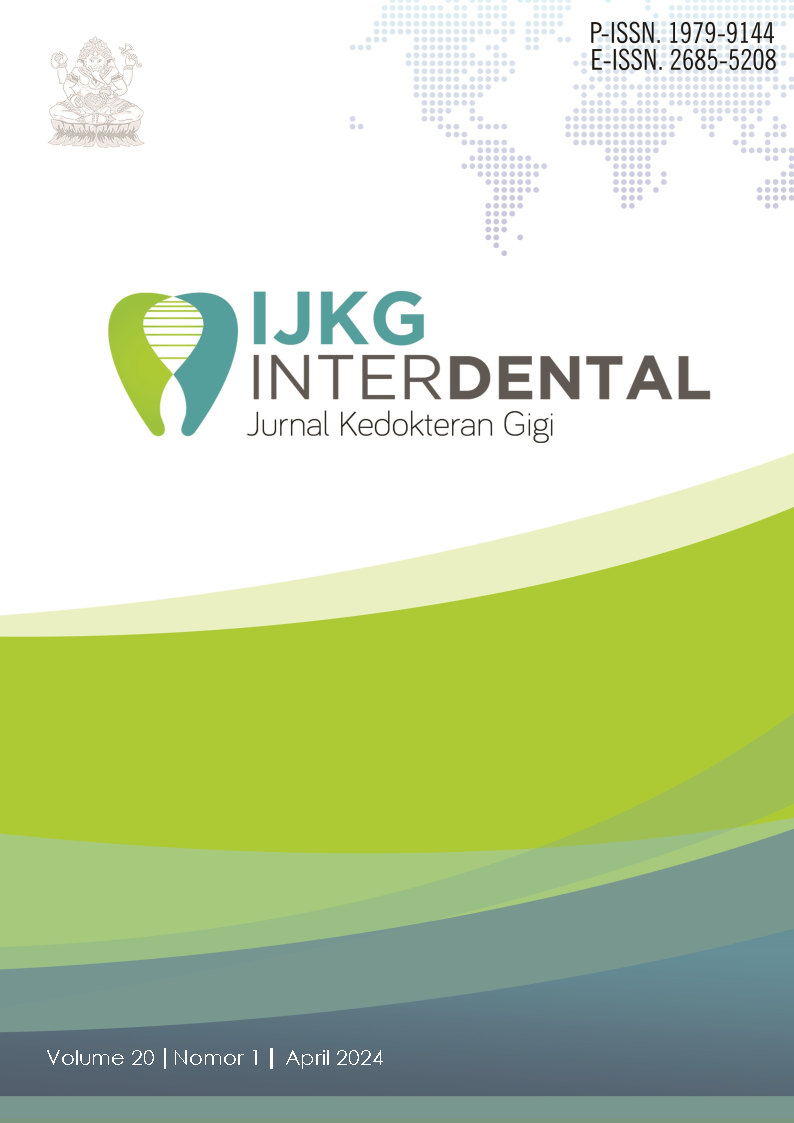DIFFERENCES IN FLOW RATE AND SALIVA PH IN USERS AND NON-USERS OF FIXED ORTHODONTIC APPLIANCES
DOI:
https://doi.org/10.46862/interdental.v20i1.8491Keywords:
Fixed Orthodontic, Salivary Flow Rate, salivary pHAbstract
Introduction: Fixed orthodontic treatment is a type of dental treatment that is very popular throughout the world, not only to improve function but also lifestyle. However, it has an impact on the condition of the oral cavity, namely the flow rate and pH of salivary, which can affect dental and oral health. This study aims to determine the differences in flow rate and saliva pH between users and non-users of fixed orthodontic devices.
Materials and Methods: This type of research is analytical observational, with a cross sectional approach. The population in this study were students class 2020, 2021, and 2022, the sample in this study was 116 students. Data collection by observation, interviews and examination. The method for measuring saliva flow rate with drainase and saliva pH using the Hanna HI98107 pH meter. Univariate and bivariate data analysis (independent sample t test).
Results and Discussions: The results of the study showed that the there was a difference in saliva flow rate in users and non-users of fixed orthodontic appliances (p-value 0.001), there is a difference in saliva pH between users and non-users (p-value 0.000).
Conclusion: The use of fixed orthodontic can affect saliva flow rate and salivary pH.
Downloads
References
Azkia R, Dwiatmoko S, Hadnyanawati H. Analisis Faktor yang Berhubungan dengan Pemilihan Operator Perawatan Ortodonti Cekat pada Remaja di SMAN 2 Bondowoso (Analysis of Factors Related to Operator Selection for Fixed Orthodontic Treatment in Teenagers of State High School 2 Bondowoso). 2021;9(3):172–81. DOI: https://doi.org/10.19184/pk.v9i3.25231
Suala HN, Wibowo D, Setyawardhana RHD. Kebutuhan Perawatan Ortodonti berdasarkan Index of Orthodontic Treatment Need Pada Remaja. Dentin. 2021;5(3):129–33. DOI: https://doi.org/10.20527/dentin.v5i3.4348
Kemenkes RI. Riset Kesehatan Dasar Tahun 2018. 2018. p. 154–65. Available from: http://www.yankes.kemkes.go.id/assets/downloads/PMK No. 57 Tahun 2013 tentang PTRM.pdf
Sekar RA, Juliani HBM. Hubungan Pemakaian Peranti Ortodonti Cekat dengan Status Psikososial Pasien Usia Dewasa Awal “Kajian pada Mahasiswa Fakultas Kedokteran Gigi Universitas Trisakti” (Laporan Penelitian). J Kedokt Gigi Terpadu. 2022;4(2):84–7. DOI: https://doi.org/10.25105/jkgt.v4i2.15568
Disa MA, Halim H. Gambaran Pengetahuan Mahasiswa Mengenai Perbedaan Efektivitas Clear Aligner dengan Ortodonti Cekat : Kajian pada Mahasiswa FKG Usakti angkatan 2019 (Laporan Penelitian). J Kedokt Gigi Terpadu. 2022;4(2):127–30. DOI: https://doi.org/10.25105/jkgt.v4i2.15664
Nasution SFS, Sundari I. Perbandingan Laju Aliran Saliva Pada Pasien Dengan dan Tanpa Piranti Ortodonti Cekat Pada Mahasiswa FKG Unsyiah. J Caninus Denstistry. 2017;2(2):78–83. DOI: 10.32734/dentika.v19i1.155
Himawati M, Herawati H. Perbandingan Persepsi Rasa Sakit Setelah Aktivasi Alat Ortodontik Lepasan pada Pasien di RSGM Unjani dengan Metode Visual Analog Scale (Vas) Comparison of Pain Perception after Activating Removable Appliance in Patients at Unjani Dental Hospital with Visu. Insisiva Dent J. 2017;6(2):9–14. DOI: https://doi.org/10.18196/di.6283
Damayanti RD, Mardiati E, Laviana A. Differences in Patient Expectations of Orthodontic Treatment with Fixed and Removable Appliances. Padjadjaran J Dent Res Students. 2021;5(2):83. DOI: https://doi.org/10.24198/pjdrs.v5i2.26766
Syahrul D, Walianto S, Suwongto PS. The Use of Chlorhexidine Mouthworks Can Reduce The Accumulation of Dental Plak in Users. Interdental Junal Kedokteran Gigi. 2023;19(1):43–8. DOI: https://doi.org/10.46862/interdental.v19i1.6095
Rahayu YC, Kurniawati A. Cairan Rongga Mulut. 2018. Edisi 2. Yogyakarta: Pustaka Panasea; 2018.
Rahayu NPTA, Suartha IN, Putriningsih PAS. Chronic Gingivitis in Local Cat. Veteriany Sci Med J. 2023;5(09):120–9. DOI: https://doi.org/10.24843/vsmj.2023.v5.i09.p01
Satria Darwis R, Endro Wahyudi H, Kartika W. Pengaruh Perawatan Ortodonti dengan Beberapa Jenis Alat Ortodonti Terhadap Perubahan pH dan Volume Saliva. Med Kartika J Kedokt dan Kesehat. 2018;1(Volume 1 No 2):126–33. DOI: https://doi.org/10.35990/mk.v1n2.p126-133
Ryudensa OA, Kusumandari W, Wulandari IS. Perbedaan Tingkat Keparahan Maloklusi dan Tingkat Kesadaran Perawatan Ortodonti antara Mahasiswa FKG dan FMIPA. Pros Mhs Semin Nas Unimus. 2019;2:156–63.
Anu V, Madan Kumar P, Shivakumar M. Salivary Flow Rate, pH and Buffering Capacity in Patients Undergoing Fixed Orthodontic Treatment - A prospective study. Indian J Dent Res. 2019;30(4):527–30. DOI: https://doi.org/10.4103/ijdr.IJDR_74_16
Sherwood L. Introduction to Human Physiology. 8th ed. Yolanda Cossio. China; 2013. 1590–1590.
Shafuria A, Dewi TS. Tatalaksana Komprehensif Pasien Severe Xerostomia yang Dipicu oleh Faktor Depresi dan Kecemasan: laporan kasus. J Kedokt Gigi Univ Padjadjaran. 2023;35(1):100. DOI: https://doi.org/10.24198/jkg.v35i1.41528
Fadila OMN, Putri DH, Tantiana. Hubungan Konsentrasi Protein Mucin Saliva Rongga Mulut Dengan Penyakit Xerostomia Pada Geriatri: Literature Review. 2023;4(2):427–35. DOI: https://doi.org/10.31004/jkt.v4i2.14373
Abrol T, Duvedi K, Thakur K, Bali Y. Assessment of Effect of Fixed Orthodontic Treatment on Salivary pH. J Adv Med Dent Scie Res [Internet]. 2020;8(1):184–6. Available from: www.jamdsr.com. DOI: 10.21276/jamdsr
Shaheed AA, Nori SA, Salman LH, Said AM. Effect of Prosthodontic and Orthodontic Appliances on Salivary pH : Prospective Study. Syst Rev Pharm. 2020;11(11):1013–5. DOI: 10.31838/srp.2020.11.146
Alshahrani I, Hameed, Syed S, Amanullah, Togoo, Kaleem S. Changes in Essential Salivary Parameters in Patient Undergoing Fixed Orthodontic Treatment. Niger J Clin Pract. 2019;22(May):1070–7. DOI: https://doi.org/10.4103/njcp.njcp_606_18
Mardelita S, Keumala CR, Liana AI, Nur A. Peningkatan Status Kebersihan Gigi Melalui Teknik Teeth-Brushing Technique in Class I Students. 2023;2023(5):91–6. DOI: http://dx.doi.org/10.30867/pade.v5i2.1545
Prasetyowati S, Puspitasari EP, Soesilaningtyas S. Systematic Literature Review : Pengaruh Kebiasaan Merokok Terhadap Penyakit Jaringan Periodontal Pada Masyarakat Di Indonesia. J Kesehat Gigi dan Mulut. 2022;4(1):35–9. DOI: https://doi.org/10.36086/jkgm.v4i1.884
Downloads
Published
How to Cite
Issue
Section
License
Copyright (c) 2024 Viona Sekar Melati, Ernawati, Ageng Wicaksono

This work is licensed under a Creative Commons Attribution-ShareAlike 4.0 International License.
- Every manuscript submitted to must observe the policy and terms set by the Interdental Jurnal Kedokteran Gigi (IJKG)
- Publication rights to manuscript content published by the Interdental Jurnal Kedokteran Gigi (IJKG) is owned by the journal with the consent and approval of the author(s) concerned.
- Full texts of electronically published manuscripts can be accessed free of charge and used according to the license shown below.













